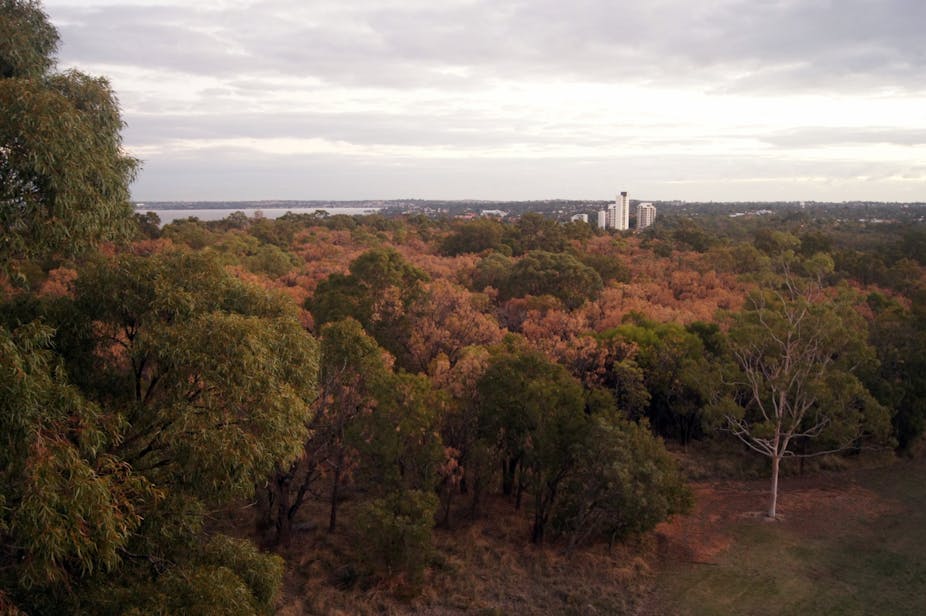Recent, unprecedented, climate-driven forest collapses in Western Australia show us that ecosystem change can be sudden, dramatic and catastrophic. These collapses are a clear signal that we must develop new strategies to mitigate or prevent the future effects of climate change in Australian woodlands and forests. But society’s view of forests is ever-changing: are we willing to understand ecosystems and adapt to changing conditions?
The south west of Western Australia has experienced a long-term climate shift since the early 1970s, resulting in dryer and hotter than average conditions. This shifted baseline, or average, has also led to more frequent extreme events. In 2010, the region experienced the driest and second hottest year on record.
These climate changes have resulted in significant decreases in stream-flow and groundwater levels. For example, formerly permanent streams now stop flowing for considerable periods. Groundwater levels have fallen up to 11 meters in some forested areas, with larger decreases in populated areas. Clearly, soil water reserves have dried out substantially and will likely continue to do so; we are now starting to see the implications of this. Although most of the West Australian society, particularly those in urban environments, may be well-buffered from these changes, ecosystems are not.
The climatic changes occurring in the south west of Western Australia are contributing to deteriorating woodland and forest health. In the past 20 years, insect infestations and fungal diseases have plagued many iconic tree species, including tuart, wandoo, flooded gum, marri, and WA peppermint, increasing their mortality rates. Many of these disorders are likely triggered or incited by changing climate conditions.

In extreme climate conditions, woodland and forest health suffers most. For instance, during the record dry and hot period in 2010 and 2011, large patches of trees throughout the region suddenly collapsed, with little recovery in some areas. Along the coastal plain surrounding Perth, some areas of Banksia woodland suffered losses as high as 70-80%, while over 500 ha of tuart woodland collapsed and over 15,000 ha of exotic pine plantations (~70% north of Perth) were destroyed. In the northern jarrah forest, over 16,000 ha of forest suddenly collapsed, with mortality rates 10.5 times greater than normal.
In several ecosystems, species have died out and not been replaced, permanently shifting vegetation structure and ecosystem function. Some believe that species and ecosystems will transition slowly in response to climate change. But following the extreme conditions experienced in 2010-11, we now know the transition in many West Australian woodlands and forests will likely occur in sudden, catastrophic, step changes. Many species may not have time to adapt.
These often sudden and dramatic shifts in vegetation health, structure and function have profound consequences on associated flora and fauna, including many critically endangered species. The Mediterranean type-ecosystems of the south west were recently named among the top 10 ecosystems most vulnerable to climate-induced tipping points and degradation by a panel of 26 leading Australian ecologists. The region is one of 35 global biodiversity hotspots, harbouring approximately 1500 plant species, most of which aren’t found anywhere else.
Among the most well known animal species is the near-extinct Carnaby’s Black Cockatoo, which relies heavily on Banksia and pine food resources made scarce by habitat conversion. Tree collapse on the coastal plain in 2010-11 likely played a role in the 34% decline in the Carnaby’s Black Cockatoo population in the Greater Perth Region between 2010 and 2011.

Many more plant and animal species are susceptible to similar collapses given the current climate trajectory and future climate predictions. Indeed, many of the traditional values that forests have provided could well be under threat.
Historically, Australian forests have been valued for the resources they provide: timber, charcoal, water, recreation, sequestered carbon, and biodiversity amongst others. With failing forest health, all of these resources are affected. The threats to forests from climate change cross ideological boundaries: this isn’t just a “green” issue. The management of forests is at a crossroads, where decisions about their future need to be made.
To do this, society needs to answer some basic questions:
Do we still value forests?
What do we want forests to look like in the future?
What are we doing now to preserve forest health in this period of climate change?
Should additional strategies and methods be developed to help forests have time to adapt to these changes?
Although the recent forest collapses in WA are tragic, they are also a valuable opportunity to understand forest susceptibility, stress thresholds, interactions among stress factors (such as insect pests and fungal pathogens) and forest tipping points. Better understanding these aspects is critical if we want to prevent future collapse.

